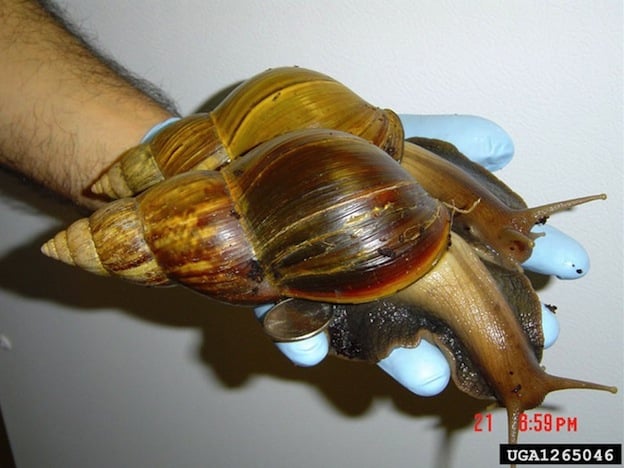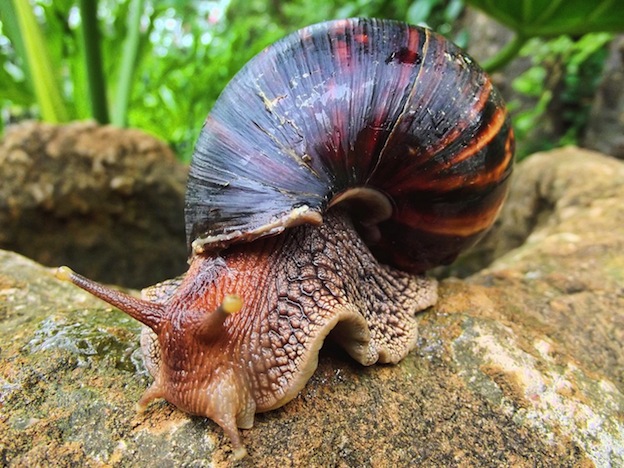Giant African Land Snail – Achatina fulica
Description
The Giant African Land Snail is one of the largest of all the terrestrial species out there. It is very rare that you will come across one but if you do pay close attention to the very unique markings that they offer. They have a light to dark brown shells with vertical stripes of a darker shade of brown on them. The average adult shell has a conical shape and its length is 4 inches although exceptional individuals have reached up to inches 7 inches.
They can range in size from about 3 inches long to about 8 inches long. They have an average life span of about 5-7 years. When they have enough food and the weather is comfortable, they tend to live much longer. Some of them have been known to live up to 10 years. It is not easy to have them in captivity because people aren’t usually educated about the temperature and the moisture that they need.
The “Achatina fulica” is considered one of the most invasive species in the world and it is considered by the United States Department of Agriculture as one of the most damaging species for the agriculture and crops in the country. It is known to eat at least 500 different species of plants.
Anatomy
A very important part of the anatomy of this snail is the tongue, which is called the radula. They have small spikes on the tongue that allow it to grab food easily. They are able to sense movement because they don’t have ears. They do have a very good sense of smell though.
They have very powerful foot muscles and this is what allows them to be able to move forward. They also release a slippery substance, a kind of mucus, as they move to help them move through rough materials without damage. Their movements are very slow which is where the saying moving at a snails pace comes in. They often blend in very well to their surroundings though which helps to make up for the fact that they can’t move very fast.
The shell is the location where the Giant African Land Snail takes refuge from predators. They will also spend time inside of their shells when the temperatures begin to dip too low at night for their comfort. While this shell is very hard, it can dry out if they don’t get enough moisture. There are several layers of this shell. Each one has its own process so that the outer shell can be strong. The shell will continue to grow as the snail does for almost one year, when you can guess how big the snail will be.
Behavior
Besides the USDA, several state governments like Idaho, Georgia and Florida among others have listed this species as highly invasive and set controls to avoid their proliferation. The global invasive species database, have listed the Achatina fulica in the top 100 of their rank and associations like invasive.org have made similar warnings.

Image Courtesy: Roberta Zimmerman, USDA APHIS, Bugwood.org
The Giant African Land Snails don’t seem to interact with each other except for when they are going to mate. They don’t have any sounds and they spend their time moving, eating, and resting.
They are considered to be active between 9 C and 29 C degrees but they are able to survive above 2 C degrees by hibernating inside of the shell during the colder months. During this time, they are able to slow their bodies down enough that they don’t need to eat or to move during that period of time. They can remain inside of the shell for several months before they emerge again.
Sometimes, you will find that these snails may aestivate in the summer months as well. This is caused by drought conditions because their shell will dry out. They are able to keep it moist by creating a barrier with a thin layer of mucus that their bodies create. In case of severe drought, they are able to aestivate up to three years.
Even so, many experts believe there has to be much more than meets the eye when it comes to these snails. Yet there hasn’t been very much in the way of research conducted on them. Many people would rather spend the time and money investigating other types of animals that seem to be more interesting to the public in general.
Habitat and Distribution
As you may have guessed by the name, The Giant African Land Snail is found in Africa. The Achatina fulica is originally native of East Africa, from Mozambique in the south to Kenia and Somalia in the north. However, they have been introduced in recent years to several locations and seem to have adapted extremely well. These areas include the Caribbean and Pacific islands. They often end up in places where they shouldn’t though due to people transporting them, either as pet trade or inadvertently.
It may surprise you to learn that it is illegal to have one of them in the United States as a pet. This is because they are considered as one of the most invasive species in the world and they have produced great damage to crops in states like Florida, Georgia or Idaho.
While you may think it is no big deal, they can deposit a very large amount of eggs, up to 200 every time they deliver a batch of eggs, and this can happen in a short span of time. Then instead of having one Giant African Land Snail you will have many munching around. Some people turn them loose to get rid of them and that is were the real trouble starts. Instead you should contact your local animal shelter and they can come pick them up.
Diet and Feeding Habits
These snails are herbivorous. They consume a wide variety of plants, fruits and vegetables. They also need calcium in order to ensure their shell stays very strong, so they will consume more of particular types of plants in order to get enough of the calcium they need. When they aren’t able to get enough calcium in their diet from plants, they may feed on bones from carcasses, sand or small stones to get it. They also consume small amounts of water that they can get from the food they consume as well.

Giant African Land Snail / Photo taken by Sonel.SA
Reproduction
The Giant African Land Snail is categorized as a hermaphrodite. This means that they possess the reproduction organs for both males and females.
While you still will need to have two of them for successful breeding, they can take on either role in the process or get them both fertilized, depending mainly on the size difference between the mating couple. They don’t have a set breeding period and on average they lay 5-6 clutches of eggs per year, containing each one close to 200 eggs per clutch with the right conditions.
Delivering close to 1,200 eggs per year and with a hatch success probability of 90%, this species can quickly become a pest.
Predators
It may surprise you to learn who the various predators are of the Giant African Land Snail. They include the caterpillar, ground beetles, other species of snails, and many types of vertebrates.
In Africa, the Giant African Land Snail is considered to be a very delicious source of food. It is nutritional in value and in many areas it is also very expensive. Many villagers will harvest these snails in order to either eat them themselves or to sell them to make money. It is important to note that this particular type of snail has been associated with different types of parasites. The failure to cook them completely can result in humans becoming very ill called meningitis.
Most humans don’t realize how delicate the protective shell of a Giant African Land Snail can be. When a person is holding one it can dry out faster. One way to prevent that is to wet your hands before picking one up to closely examine it. Failure to do so can result in the shells drying up and then these snails don’t have any way to protect their bodies.
Since they also feed on plant life, the use of pesticides is a common cause of death for the Giant African Land Snail. In most areas they are considered to be nothing more than destructive pests. They can affect the quality of foods being grown so preventing them from being in the area often takes drastic measures.
Sem comentários:
Enviar um comentário